A1.2
1/27
There's no tags or description
Looks like no tags are added yet.
Name | Mastery | Learn | Test | Matching | Spaced |
|---|
No study sessions yet.
28 Terms
State the two primary functions of nucleic acids.
Storage of genetic information
Direct protein synthesis
State the two types of nucleic acids used in cells.
RNA & DNA
Outline the meaning and implication of DNA being the genetic material of all living organisms.
Meaning:
All living organisms use DNA as the genetic material.
Implication:
The use of the genetic code across all forms of life is evidence of universal common ancestry of life. The sequences of DNA in cells can be analyzed and compared to determine evolutionary relationships between organisms. The more similar the sequence, the more closely related the organisms.
Do RNA viruses falsify the claim that all living things use DNA as their genetic material? Why or why not?
No- Some viruses use RNA as their genetic material. However, because viruses are not made of cells, they are not considered to be living.
List the three components of a nucleotide.
Phosphate group, 5-C sugar, Nitrogenous base
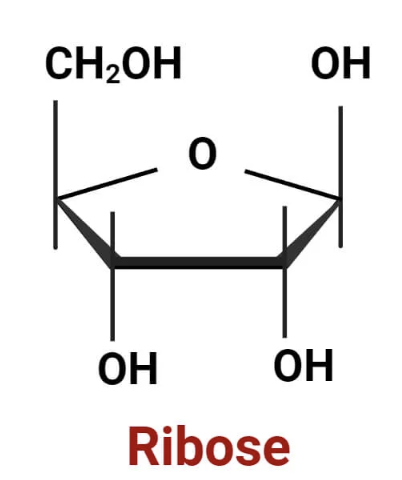
Identify and label the carbons of this pentose sugar.

Draw the basic structure of a single nucleotide (using circle, pentagon and rectangle).
Define “backbone” as related to nucleic acid structure.
In the context of nucleic acid structure, the "backbone" refers to the repeating chain of alternating sugar molecules (deoxyribose in DNA, ribose in RNA) and phosphate groups that form the structural framework of the molecule
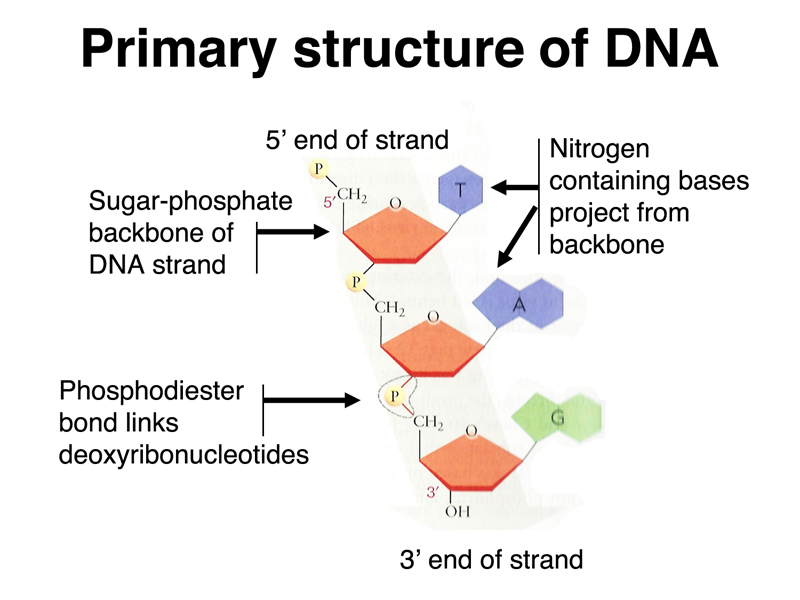
Explain how nucleotides connect to form a nucleic acid polymer.
Nucleotides a linked into a single strand via a condensation reaction
bonds are formed between the phosphate of one nucleotide and the pentose sugar of the next
The phosphate group (attached to the 5'-C of the sugar) joins with the hydroxyl (OH) group attached to the 3'-C of the sugar
This results in a covelant bond (phosphodiester bond) between the two nucleotides and the formation of a water molecule
Successive condensation reactions between nucleotides results in the formation of a long single strand

State the names of the nitrogenous bases found in DNA
Adenine (A), Thymine (T), Cytosine (C), Guanine (G)
State the names of the nitrogenous bases found in RNA
Adenine (A), Uracil (U), Cytosine (C), Guanine (G)
State a similarity and a difference between the nitrogenous bases.
A similarity between nitrogenous bases is that they all contain nitrogen atoms and are crucial for forming base pairs in nucleic acids like DNA and RNA; a key difference is that some bases are classified as purines (double-ringed structure like adenine and guanine) while others are pyrimidines (single-ringed structure like cytosine and thymine). [Any other accurate answer is also good!]
![<p>A similarity between nitrogenous bases is that they all contain nitrogen atoms and are crucial for forming base pairs in nucleic acids like DNA and RNA; a key difference is that some bases are classified as purines (double-ringed structure like adenine and guanine) while others are pyrimidines (single-ringed structure like cytosine and thymine). [Any other accurate answer is also good!]</p>](https://knowt-user-attachments.s3.amazonaws.com/6f6bd304-bcda-44af-9769-caf8a86b4448.png)
Outline how the sequence of bases in a nucleic acid serves as a ‘code.’
Three bases form a codon, which codes for a specific amino acid
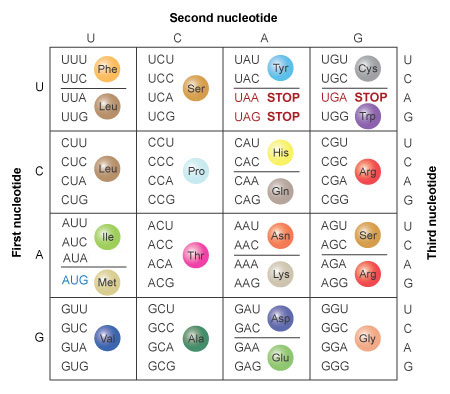
Define gene.
A gene is a heritable factor that consists of a length of DNA and influences a specific characteristic.
Describe the condensation reaction that forms a polymer of RNA from RNA nucleotides.
A condensation reaction that forms a polymer of RNA from RNA nucleotides occurs when the phosphate group on the 5' carbon of one nucleotide reacts with the hydroxyl group on the 3' carbon of another nucleotide, forming a phosphodiester bond and releasing a water molecule
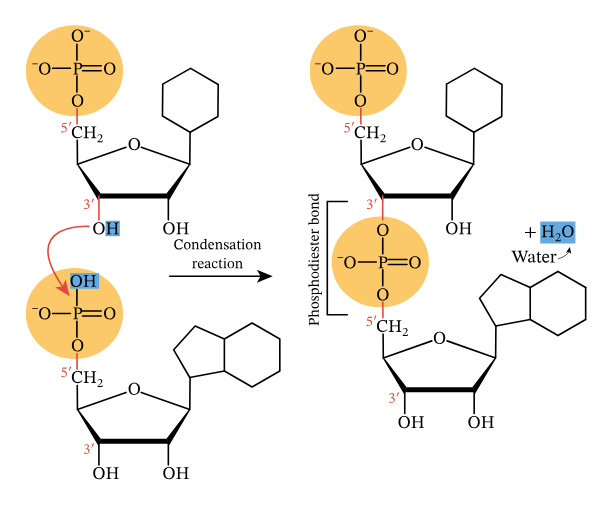
Identify the monomer and polymer of an RNA molecule.
The monomer of an RNA molecule is a nucleotide; the polymer is the RNA molecule itself
Draw a short section of an RNA polymer (using circle, pentagon and rectangle)
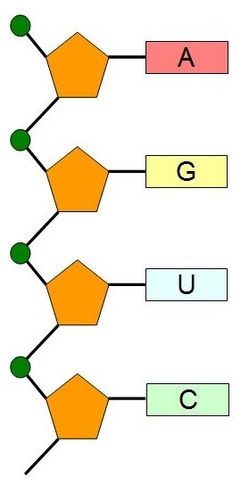
Describe the structure of a DNA double helix.
DNA is a double helix structure.
It consists of two long, linear strands of nucleotides.
The strands twist around each other, resembling a twisted ladder.
The "rungs" are formed by pairs of nitrogenous bases held together by hydrogen bonds.
The "sides" are made of alternating sugar (deoxyribose) and phosphate groups, forming the sugar-phosphate backbone.
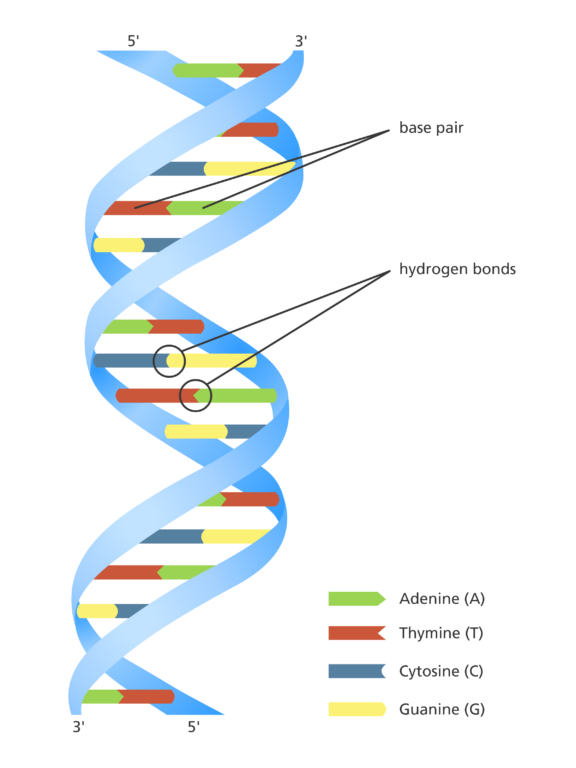
Outline the complementary base pairing rule, including the type and number of bonds between bases.
Base pairs: Adenine (A) pairs with thymine (T), and cytosine (C) pairs with guanine (G).
Bond type: The bonds between complementary base pairs are hydrogen bonds.
Number of bonds: A-T pairs have two hydrogen bonds, while C-G pairs have three hydrogen bonds
Define antiparallel in relation to DNA structure.
The two DNA strands run in opposite directions, called antiparallel, with the 5' end of one strand aligning with the 3' end of the other.
Compare and contrast the structures of DNA and RNA.
Key Differences:
Strands:
DNA is (typically) double-stranded, meaning two strands twist around each other to form a double helix, while RNA (typically) is single-stranded.
Sugar Molecule:
DNA contains deoxyribose sugar in its backbone, while RNA contains ribose sugar.
Base Pairs:
Both DNA and RNA use the bases adenine (A), cytosine (C), and guanine (G), but DNA uses thymine (T) as the complementary base to adenine, while RNA uses uracil (U).
Similarities:
Nucleotide Structure:
Both DNA and RNA are composed of nucleotides, which consist of a sugar molecule, a phosphate group, and a nitrogenous base.
Base Pairing:
Both DNA and RNA form base pairs based on complementary base pairing rules (A with T/U, C with G).
Compare and contrast the functions of DNA and RNA.
Both DNA and RNA are crucial for genetic information storage and transfer, with DNA acting as the primary storage molecule and RNA playing a role in protein synthesis.
Compare and contrast the location of DNA and RNA in prokaryotic and eukaryotic cells.
The prokaryotic DNA is found in a coiled loop floating in the cytoplasm, whereas the eukaryotic DNA is found inside the nucleus. In both types of cells, RNA is produced in the nucleus (in eukaryotes) or cytoplasm (in prokaryotes) and is in the cytoplasm for protein synthesis. The key difference is that in eukaryotes, the RNA must travel from the nucleus to the cytoplasm, whereas in prokaryotes, it is produced in the cytoplasm and stays in the cytoplasm.
Outline the role of complementary base pairing in transmitting the genetic code in translation.
During translation, an RNA strand is used as a template for the creation of a polypeptide. Because of the base pairing rule, the mRNA codon will only bind with the complementary tRNA anticodon (A to U, C to G). The complementary base paring ensures the correct amino acid are brought in the correct sequence to the ribosome.
True/False: There is a limitless diversity of DNA base sequences.
True
Why is there a limitless diversity of DNA base sequences, even though there are only 4 DNA bases?
although only four different bases (A, T, C, and G) exist, they can be combined in an almost infinite number of ways to create unique sequences, with the potential length of a DNA strand further multiplying the possible combinations, allowing for vast genetic diversity even with a limited set of building blocks
What does it mean to say the genetic code is “universal”?
the genetic code is largely the same across all living organisms on Earth, meaning that the same codon (sequence of three nucleotides) will code for the same amino acid in a bacteria, a plant, and a human
Outline why conservation of the genetic code across all forms of life is evidence of common ancestry.
it is highly improbable that such a complex system of codon-amino acid pairings would have evolved independently multiple times in different organisms